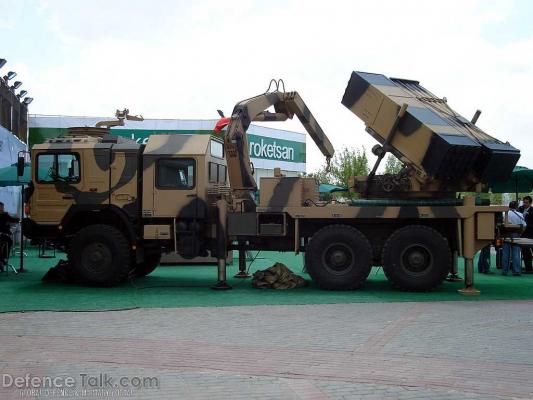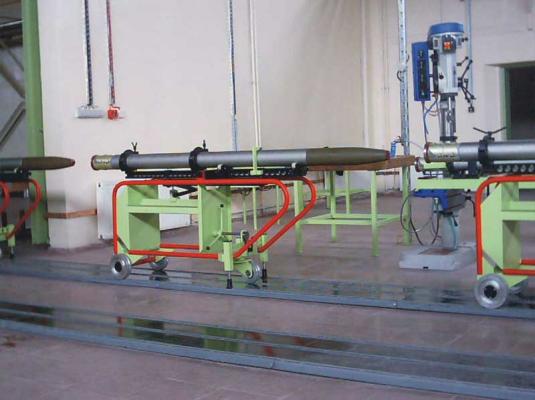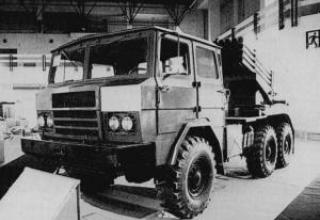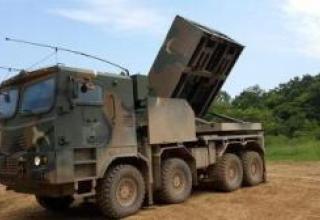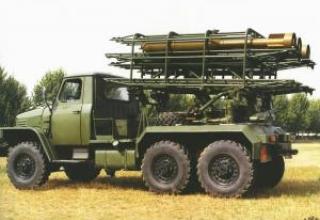The T-122 "Sakarya" multiple launch rocket system (MRLS) is designed to engage manpower, military equipment, fortifications, army control points, administrative and residential areas of the enemy when fired from closed firing positions at any time of the day under any weather conditions.
Developed by the Turkish company "Roketsan Missiles Industries Inc.
At present, the RSZO T-122 "Sakarya" is in serial production and goes into service of the Turkish ground forces. The system is constantly being improved: new ammunition samples have been created, the fire control system, the combat vehicle has been modernized. A promising solution is the replacement of the guide tube package by two monoblocks of 20 disposable transport and launch containers, which significantly increases reliability and reduces the recharging time of the combat vehicle. The upgraded version was first shown at IDEF-2005.
RSZO T-122 is offered to the foreign market and has a certain export potential, as it is widely unified with the Russian RSZO BM-21 "Grad" and its numerous clones assembled in different countries.
Composition:
Composition of RCDS T-122:
- Combat vehicle (BM) T-122;
- 122-mm Unguided Rockets (NURS);
- transport and charging machine;
- battery command post.
BM T-122 is made on the chassis of a German truck with cross-country ability MAN (wheel arrangement 6x6) of various modifications. The artillery part of the early BM variants (see photo) includes two half-packages of 20 tubular guides in each, a swivel base with guidance mechanisms and sighting devices, as well as electrical and hydraulic equipment. The tubular guides are mounted and adjusted using a lightweight structural frame. They are recharged manually.
The last variants of fighting machine T-122 are equipped with two monoblocks from 20 disposable transport and start-up containers (TPK), made of polymer composite materials. They are installed on the combat vehicle by means of an onboard crane BM. The recharging time in this case is about 5 minutes. The monoblocks are equipped with rockets at the manufacturer's plant and sealed. The NURS does not require maintenance during the entire lifetime of the unit, the data entry into the fuse of the jet projectile in preparation for firing is done remotely by means of the fire control system. The technology used ensures increased mobility of the LM, the possibility of mounting the monoblock on various types of carriers, and ease of storage and charging.
The guidance mechanisms equipped with power drives make it possible to guide the guide package in the vertical plane from 0° to the maximum elevation angle of +55°. Horizontal alignment angle ±110° from the longitudinal axis of the machine. Electric and mechanical actuators are designed to be placed on different starting systems. The M-12 panoramic sight is mounted on the left side of the combat vehicle. Four hydraulic jacks, mounted on both sides of the vehicle, rest on the ground when the vehicle is put into combat position. Behind the main cabin there is a fully enclosed cabin to accommodate the calculation. Standard calculation of the LM consists of five numbers (in combat conditions the calculation can be reduced to 3 numbers). Vehicle modifications can be equipped with armored cabins and equipped with weapons of mass destruction protection systems, as well as air conditioning system. A 7.62 mm machine gun is mounted on the roof of the cab.
The area of destruction by full salvo BM (40 NURS with blasted BC) is 250,000 sq.m. at a range from 3 to 40 km. The time to deploy the machine gun in a firing position is less than 15 minutes and about 5 minutes using a satellite navigation system. The combat mission is performed both independently and as part of a battery. The battery command post provides control of six T-122s and support facilities.
The T-122 combat vehicle is equipped with a modern fire control system "BORA-2100", which provides:
- testing the system before and during the shooting;
- automatic calculation of raw data for NURS firing with different types of head units;
- automatic guidance package guidance without leaving the cabin;
- single NURS firing or volley firing with a firing rate of 2 s;
- storage of data on the location of 20 targets;
- input of meteorological information in METSM or similar formats.
The main types of T-122 RSF ammunition are:
- SR-122 and SRB-122 with a flying range of 20 km;
- TR-122 and TRB-122 with extended range up to 40 km and RDTT with mixed fuel charge;
- TRK-122 with a flying range of 30 km and a cassette head end.
NURS SR-122 and TR-122 are equipped with a high-explosive head unit (HU) and are designed to act against lightly armored targets and enemy live force. The Head Unit of this type has a 6.5 kg explosive charge (BB) based on TNT and hexogen and a contact fuse. When detonated, the HC produces about 2400 fragments and provides a range of more than 20m.
NURS SRB-122 and TRB-122 have HC of shrapnel-type with ready-made hitting elements (HCE) in the form of steel balls. The number of GGEs is over 5500. Weight of BB charge - 4 kg. HC is completed with a non-contact type fuse and has a radius of destruction more than 40m.
The NURS TRK-122 cassette chamber is designed to destroy armored vehicles, manpower, warehouses and fortifications. It is equipped with 50 cumulative shrapnel fighting elements (COBE) and 6 incendiary batteries. The combat element charge is based on hexogen and WAX. The 0.28 kg SCEN provides a kill radius of 7.5 m. The charge is based on hexogen and WAX.
The monoblock of the upgraded T-122 has a width of 800 mm, height of 750 mm, length of 3000 mm (for TRB-122) and 3250 mm (for TRK-122). The weight of the monoblock equipped with twenty NURS TRB-122 is 1780 kg, twenty TRK-122 - 1890 kg.
122-mm NURS of Roketsan company are unified with NURS of Russian RSZO BM-21 "Grad" and can be used as a part of this system or its many variants assembled in different parts of the world. In its turn, BM T-122 can use all types of ammunition developed for BM-21.
Characteristics:
| Fighting vehicle T-122 | |
| Length,mm | 9200 |
| Width, mm | 2500 |
| Height, mm | 3100 |
| Length in hiking position,mm | 8600 |
| Height in camping position,mm | 3050 |
| Weight of loaded BM,kg | 20600 (22200; 22500) |
| Weight of not loaded BM,kg | 19500 |
| Maximum travel speed, km/h | 75 |
| Maximum gradient to be crossed,% | 60 |
| Power reserve, km | 970 |
| Features 122-mm NURS | |||||
| Symbol | TR-122 | TRB-122 | TRK-122 | SR-122 | SRB-122 |
| Minimum flight range, m | 10000 | 16000 | 3000 | ||
| Maximum flight range, m | 40000 | 30000 | 20000 | ||
| Fuel type | mixed | ballistics | |||
| The length of the projectile, mm | 2930 | 3240 | 2900 | ||
| Weight NURS, kg | 65.9 | 71.6 | 66.6 | 67.1 | |
| Weight HF, kg | 18.4 | 22.9 | 18.4 | ||
| Type of PPP | blast | GGE fragmentary | cassette | blast | GGE fragmentary |
| Fuse type | drum | non-contact | electronic temporary |
drum | non-contact |
| Temperature range for storage and operation, °С | between -40 and +60 | between -32 and +50 | |||
| Period of storage, years. | 10 | ||||
Testing:
Strela-1 and Strela-1M complexes were widely exported by the USSR abroad. They were supplied to the countries-participants of the Warsaw Pact, to Yugoslavia, to the states of Asia (Iraq, Syria, North Yemen, India, Vietnam), Africa (Algeria, Angola, Benin, Egypt, Guinea, Guinea-Bissau, Libya, Madagascar, Mali, Mauritania, Mozambique) and Latin America (Cuba, Nicaragua), confirming their rather high efficiency and ease of use during military conflicts and during training firing.
The first use of the Arrow 1 SAM system was in the Bekaa Valley in southern Lebanon in 1981. In December 1983, these SAMs were shot down by American A-6E and A-7E aircraft (the latter, probably, was hit by portable SAMs of Strela-2 family). In the same year, several Arrow 1 SAM systems were captured by South African invaders in southern Angola.
Sources:
- 122 mm Artillery Rocket Systems /"Roketsan"/.
- Factsheets Database - T-122 - 122 mm Artillery Rocket Systems
- Turkish Armed Forces
- Гуров С.В. "Реактивные системы залпового огня" .-Тула.: "Пересвет", 2006- 432с.
